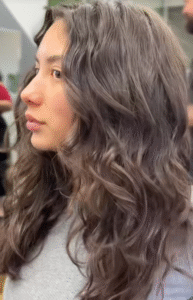Curly hair has always been more than just a feature—it’s a statement of nature’s creativity. Every curl, wave, and coil is formed by a delicate balance of biology and individuality, creating a texture that’s as unique as the person wearing it. It’s hair that doesn’t conform; it moves, grows, and lives on its own terms.
Scientifically, curls are born from the shape of the hair follicle. Straight hair grows from round follicles, while curly hair comes from oval or asymmetrical ones, giving each strand its natural curve. The tighter the curve, the more pronounced the spiral. This beautiful twist in structure gives curly hair its volume and character—but it also means it needs special care to stay healthy and hydrated.
Because of those twists and turns, curly hair is naturally drier. The oils your scalp produces struggle to travel down the spiral-shaped strands, leaving the ends more prone to dryness and breakage. This is why moisture is the foundation of curl care. Hydrating shampoos, creamy conditioners, and nourishing masks are essential to keeping curls soft, shiny, and defined.
But curly hair isn’t meant to be controlled—it’s meant to be understood. The more you fight it with heat, harsh brushing, or chemicals, the more it resists. The secret lies in working with your hair, not against it. Using wide-tooth combs, diffusers, or even just your fingers helps keep curls intact. Gentle drying with a microfiber towel or cotton T-shirt prevents frizz and protects the natural curl pattern.
Beyond routine, curly hair carries meaning. It’s bold yet soft, unpredictable yet graceful. It’s the kind of beauty that changes from day to day—sometimes wild and full of bounce, sometimes calm and wavy. That’s part of its magic: curly hair refuses to be static. It evolves with the weather, humidity, and even mood. Every curl tells a new story.
In many cultures, curly hair has long been celebrated as a symbol of freedom and individuality. Artists, writers, and icons throughout history have depicted curls as representations of power and emotion. There’s something inherently expressive about them—they move with passion, they catch the light, they frame faces with character. Curly hair isn’t just seen; it’s felt.
In recent years, there’s been a quiet revolution—people all over the world have stopped hiding their curls. After decades of heat straightening and chemical treatments, many are learning to embrace what nature gave them. The “curly hair movement” isn’t just about beauty—it’s about acceptance. It’s about saying, “I don’t have to change to be enough.” Each curl becomes a quiet act of confidence, a reminder that authenticity is far more powerful than perfection.
Curly hair also teaches patience. It can take time to learn its needs, to understand what makes it thrive. There are no shortcuts or one-size-fits-all solutions. Every curl type is different, with its own texture, density, and pattern. But once you discover the balance—when your hair finally starts to cooperate, shine, and bounce freely—it feels like a small victory that radiates pride and self-love.
Curls are art in motion. They reflect light in ways straight hair never could, creating dimension and depth that changes with every step. They demand care but give confidence in return. They remind us that beauty doesn’t need to be uniform—it needs to be real.
So, if you’ve ever felt the urge to tame your curls, pause. Let them live, breathe, and move the way they were meant to. Because curly hair isn’t something to manage—it’s something to celebrate. It’s proof that the most beautiful things in life are the ones that refuse to be straightened out.





